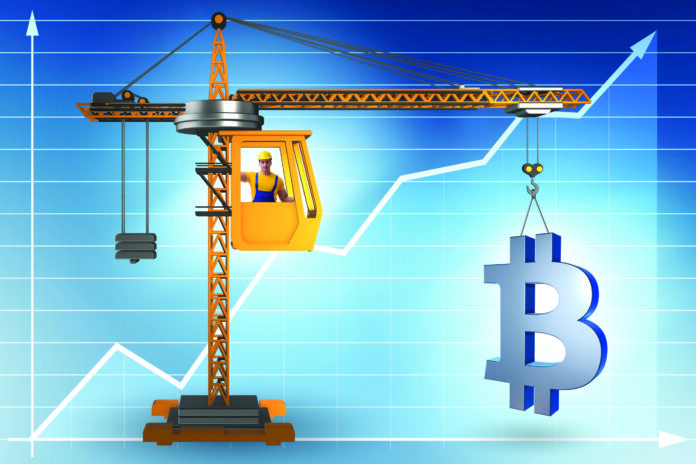Blockchain technology will disrupt and streamline construction

by Belinda Carr
- This Web 3.0 technology can eliminate disputes by creating an immutable record of all transactions on a project
- New blockchain-enabled software can save time and money through streamlined payments and better supply chain management
- Blockchain-enabled BIM ensures that everyone on the product actually follows the model
- Like all software, however, the output’s usefulness depends on the assumptions underlying the data
Construction is one of the world’s largest industries, with around $10 trillion spent on goods and services every year. It’s also one of the most highly fragmented. Productivity has been flat for decades, while that of manufacturing has nearly doubled over the same period and continues to improve.
To improve its efficiency and productivity, the construction industry has to embrace automation and digitization.
The digital revolution has, of course, been going on for decades. It began with the switch from hand drawings on paper to computer-aided design, or CAD. This enabled better communication, more specialized trades and faster project times.
The next phase has been centered on the internet and Web 2.0 technology, which has seen software platforms moving from the desktop to the web. This phase, which we’re mostly still in, also includes things like social media and my YouTube channel, as well as the collection and exploitation of data, drones, smart sensors, tracking software and the Internet of Things.
In the construction industry, Web 2.0 has enabled the growth of Building Information Modeling, or BIM, which makes the design process more integrated. It has also included sensors that monitor site conditions and workplace safety, as well as Virtual Reality and Augmented Reality, which is being used in pitch meetings to explain projects to clients.
However, if you follow technology trends, you know that we are now entering the Web 3.0 era. This is a new digital revolution that will be based on blockchain technology and the decentralization of data.
Most people know of blockchain as the technology underlying Bitcoin and other cryptocurrencies, but it actually has far more uses. I predict that many industries, including construction, will embrace it in the coming years. In this article, I look at potential applications of blockchain in architecture, engineering and construction, along with the roadblocks to its implementation.
Blockchain Defined
A blockchain is a digital ledger that stores information in records – called blocks – that are linked together chronologically, like a chain. Each block has three main components:
1. Data, such as time-stamped transactions or agreements
2. A hash, which is that block’s digital fingerprint or unique identifier
3. The hash of the previous block in the chain
Once a block has been added to the chain, the information in it cannot be changed. Any new information has to be put into a new block, which is then added to the chain. This creates an unalterable record of all transactions in a project. If a dispute arises at some point, everyone can see who did what, and when.
A blockchain ledger is made secure with a combination of cryptography and consensus decision-making. Here’s how they work together:
- Cryptography. Every transaction in every block is recorded using encrypted data. Any attempt to tamper with the data will create a new hash, rather than altering the old data.
- Consensus. Blockchain is a peer-to-peer network that’s controlled collectively by all users rather than by a central authority. That means a block can’t be added to the chain unless a majority of the network’s computers (or “nodes”) approve it. A hash generated by a hacking attempt will be recognized as such by the network and won’t be added to the chain.
One huge advantage of blockchain’s built-in security is that it eliminates the need for trust. In our current system, business transactions depend on trust between management and the employees of an organization and between an organization and its partners or customers. Trust must be verified via third-party intermediaries like notaries, banks and lawyers, all of whom add considerable time and money to transactions.
By keeping data secure and unalterable, blockchain technology allows us to cut out these intermediaries, save money, and speed up decision-making. Trust is created by the security of the network itself.
Blockchain and Construction
As I noted above, the current media attention and hype around blockchain is focused on cryptocurrencies like Bitcoin, but there are many other practical applications. In the architecture and construction industry, for example, they include management of contracts, labor, payments and building supplies.
Smart Contracts. Construction projects involve a large number of companies. The general contractor has to wait to get contracts, change orders and addendums from all parties. The contractor also has to pay all the companies involved and wait for their status reports.
Blockchain allows for smart, digital contracts. The companies involved define the rules, deadlines and penalties before the project starts, and then the blockchain automatically enforces them. The blockchain can also record the number of hours each laborer works.
Skill verification. Through blockchain, vendors and suppliers can use unique identifiers to record their performance and grow their reputation. Unlike LinkedIn listings and resumes, which are self-reported, the blockchain makes it easier to verify and check the credentials and past roles of a company, or individual, before hiring them.
Payment tracking. Late payments and cash flow issues are continuing problems. Transactions between parties can include invoice errors, payment errors, bank holidays, currency conversion fees, etc. The average payment time for small- and medium-sized companies is over 80 days.
Blockchain applications can be linked to bank accounts or cryptocurrency accounts to send faster payments. For instance, Builderchain and Builder Pay are blockchain-based construction marketplaces that distribute funds from the construction loan to the project owner, subcontractors and manufacturers. Each transaction is verified via a token— a digital asset that gives the bearer rights to a specific item, in this case, a payment.
Supply chain management. The fragility of our global supply chain has been exposed over the last two years. Blockchain systems can improve supply chain robustness because materials are logged and traced, delivery time is easier, quicker and less bureaucratic, and dispute resolution is faster. You have better control of inventory and you can order and receive goods as needed, which reduces waste.
These advantages can lead to lower costs and faster schedules. Maersk and IBM launched a blockchain-based system in 2017 called the TradeLens Platform. It is an interconnected ecosystem of supply chain partners—cargo owners, ocean and inland carriers, freight forwarders, customs authorities and more. It offers a holistic view of shipment data and documents.
Blockchain and BIM
Blockchain technology also promises to make BIM more powerful.
A blockchain-enabled Building Information Model would act as a single source and dashboard of all information in a project including supply chain information, source of materials, payment details, revisions, etc. All parties would work to match the physical construction to the BIM model and deviations from the model would result in penalties. The combination of BIM and blockchain in smart contracts means you could make payments, send out material orders, hold subs accountable and improve transparency, communication and workmanship on a project.
This isn’t just theory—it’s already happening. A French company called BIMCHAIN has developed a blockchain application to validate the origin, ownership and integrity of the data in the process of transferring the BIM models. This solution allows you to notarize and verify any type of data and BIM file in the blockchain.
The Road Ahead
As exciting as these developments are, the reality is that it will be some time before blockchain technology becomes the norm in construction. Many companies are still hesitant to adopt 3D modeling software and continue to plan projects in 2D. Blockchain will require a huge cultural and organizational shift and the development of new business models. Building codes and regulations will be particularly slow to adapt to blockchain documents.
This means we will be juggling three mediums for a while: a paper trail, an email trail and a blockchain trail. Eventually, however, blockchain applications will need to work independently and seamlessly without manual monitoring.
In addition, the cost of the system could slow down adoption. The construction industry already runs on narrow profit margins, so it’s unrealistic to expect small- and medium-sized companies to shell out money on new technology and new tech staff right now.
Another problem is the belief that BIM models are the source of truth. I haven’t worked on a single project where the 3D model was flawless.
It seems to me that some blockchain developers work under the assumption that engineers and designers always get it right, while people on job sites routinely do things wrong, which isn’t true. Contractors and subcontractors are the people who make drawings work. Blockchain technology can make BIM more powerful, provided it takes modeling errors into account.
Also, a made-for-construction blockchain cannot operate on the same principles as those for the shipping or automobile industries because we don’t have that level of precision and automation. Many aspects of construction simply cannot be automated, such as responding to Requests for Information or RFIs.
My prediction is that blockchain will first prove its worth for large companies building complex projects, but that small- to medium-sized companies that still model in 2D will be slow to adopt it. However, I’m encouraged by people in the construction industry discussing the idea of blockchain even in its nascency, so I predict its use will steadily grow.
Belinda Carr is a Dallas, Texas-based architect, building science researcher and content creator. Find her at YouTube.com/BelindaCarr.

















